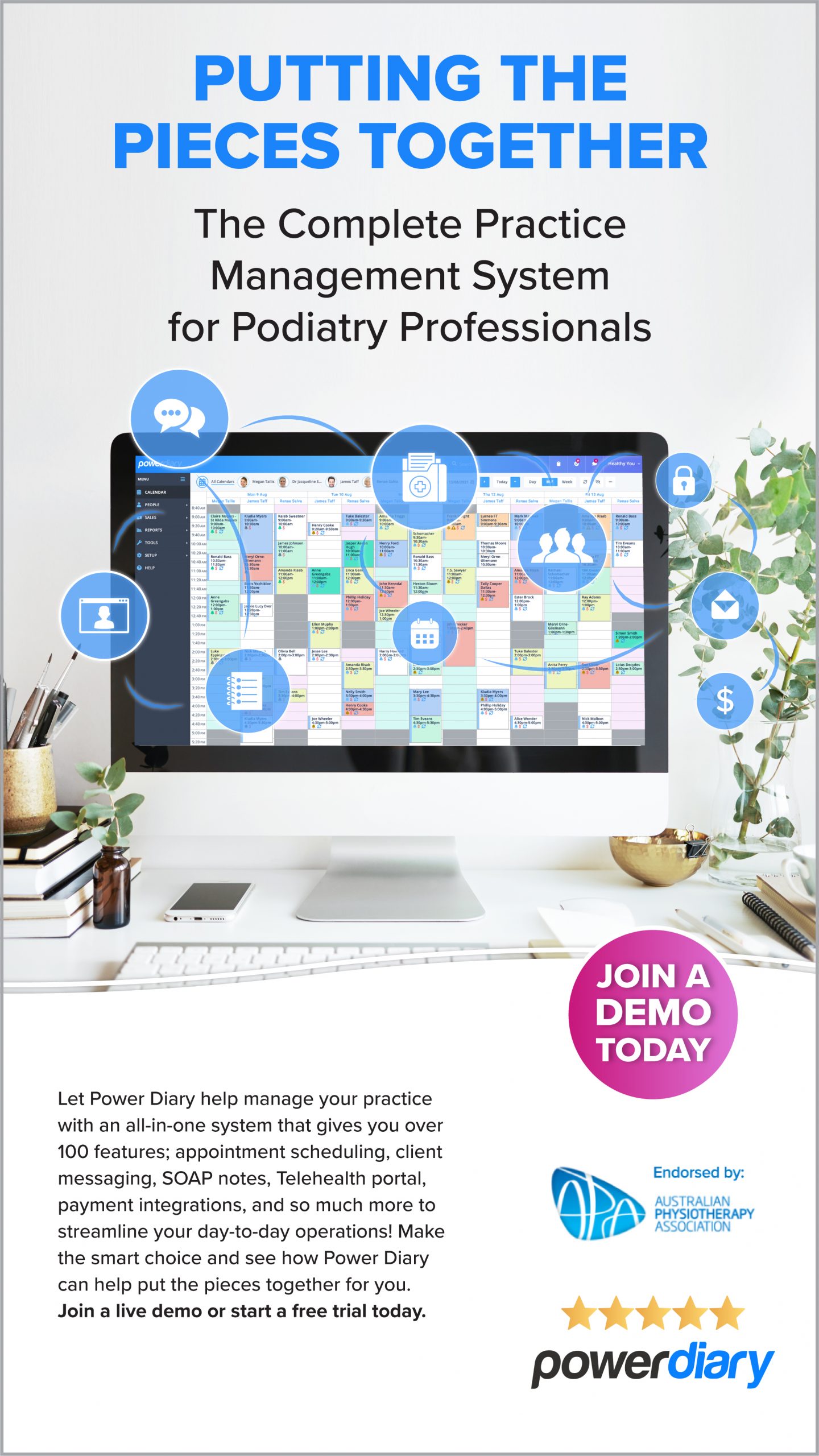
Foot Health Week is nearly here!
Are you getting ready for Foot Health Week? It’s taking place between 10 – 18 October this year and this year’s theme is all about celebrating you, the podiatrist.
We are advocating for the role of podiatry across our nationwide communities, especially during this year’s Foot Health Week. The goal is to drive awareness – not only to what you do as a podiatrist, but to also surprise people to learn that it is probably so much more than first imagined.
Working behind the scenes
In the lead up to, and throughout October 10 to 18, we’ll be working hard to try and celebrate podiatrists via TV appearances, national newspapers, local press and everything in between; ready to drive as much publicity as possible to the power of podiatry.
Get involved
It’s a great time for you to get involved and perhaps generate your own local media opportunities (chat to us and we can guide you). Don’t forget to be active on social media and tag us and use those hashtags*. And keep an eye out for your member pack in the lead up to the week, which contains a copy of Foot Health Australia magazine for your waiting area (amongst other goodies). This pack has even more detailed information on how you can get involved in Foot Health Week this year, so keep an eye out for it.
Don’t forget our socials
Tag away on the following platforms!
Foot Health Australia Facebook: @foothealthau
Foot Health Australia Instagram: @foothealthau
APodA Facebook: @AustralianPodiatryAssociation
APodA Instagram: @australianpodiatry
APodA LinkedIn: @australian-podiatry-association
APodA Twitter: @APodA_National
#LoveYourFeet #FootHealthWeek2022 #podiatryau #FootHealthAus
We’ll see you online or in person – let’s make this a success, together.
Bill Mackieson inspires us all

Check out our classifieds
Have you looked at our popular classifieds lately? Here’s why you should consider it.
Our classifieds are very popular among podiatrists who hire across a range of roles and locations. Did you also know that our classifieds are:
- Where clinical roles and research roles are advertised. These roles relate not just to the podiatry sector but also other industry entities. Keep an eye out if this appeals to you and don’t forget to let fellow members know!
- Where practices and items are for sale. If you’re looking to buy an established podiatry practice this is your go to source!
- A great way to save money. As a member benefit, you can save $400 for each classifieds advert you post (and this includes a social media post to our Facebook state groups).
- A great place to find a graduate. If you’re considering employing a graduate for the new year, September and October is the time to start the recruitment process with a job advert on the classifieds page. And if you’re after HR tips on graduate recruitment go to the HR portal for the latest recruitment ‘how to’ recruitment guides (including contract templates and rates of pay).
Get involved
To post an ad (or look up opportunities), head here.
A case study: The endorsement process

The call for allied health funding in aged care
The new Australian National Aged Care Classification Care Funding Model (AN-ACC) is set to replace the aged care funding instruments (ACFI) as of 1 October 2022. What does this new aged care funding model mean for podiatrists?
As of 1 October 2022, the AN-ACC, a new aged care funding model will replace the aged care funding instruments (ACFI). The premise is that the AN-ACC tool will provide greater equitable care funding to providers so they are able to cater for their residents’ needs to a greater degree. The tool is understood to work similar to NDIS, where there is an initial assessment that will aid in classifying and subsequently allocating funding.
AN-ACC access issues
To access this new funding model, assessment is required by a physical therapist or an occupational therapist as a baseline, and there are incentives to improve clients’ functional outcomes which does lend itself to allied health.
This funding model is designed as a strengths-based approach to facilitate better functional outcomes for clients. However, while the AN-ACC tool is made available to residents for allied health services, unlike other services (such as nursing and personal care staff) allied health has not been benchmarked regarding a specific set of allocated care minutes. In fact, to date there has been no allocation under the current reform of minimum care minutes per resident for allied health services.
Or put another way, without benchmarking a set amount of minimum care minutes per patient for allied health services, this will enable residential aged care facilities to allocate as they see appropriate.
This presents the potential risk of podiatrists being ‘left behind’, given there can be a lack of value around the work of podiatrists in residential aged care facilities when it comes to understanding the full scope of practice – instead of being perceived as just ‘cutting toenails’ in these facilities.
Where to from here?
In July this year, Allied Health Professions Australia (AHPA) published their Policy Brief – Allied health funding in residential aged care. This document highlights the current approach of the reform, current provider spending and the possible impact that AN-ACC will have on allied health funding.
The plan for AHPA, and certainly for APodA, is to work closely with the Labor Government and related networks to ensure pre-election commitments are realised. In particular, to advocate for equitable and fair healthcare access – and a well-resourced multidisciplinary model must be central to this promise. Such a model needs to ensure allied health services, like podiatry, have a strong place in residential aged care services.
In other advocacy news
The Support at Home Program, Home Care Packages Program and Short Term Restorative Care Program, (which were all scheduled to replace the current Commonwealth Home Support Program), have now been pushed back from a July 2023 start date to 1 July 2024. This welcome delay reflects the Aged Care Royal Commission Final Report recommendations.
APodA will continue its advocacy involvement in the meantime.

Football boot selection: what to consider


A podiatrist working with footballers can help with the selection of boots that allow players to perform to their best, while also minimising injury risk and maximising comfort. Here’s some tips to bear in mind.
As football finals near for a variety of codes, we’ll get to see the best-of-the-best go on long searching runs, sprint, pivot, rapidly change direction, accelerate, and decelerate….all while executing football skills. We will also see an array of different football boots worn by players, suggesting there is no one ideal boot for all.
So, let’s look at footwear features that should be considered when selecting football boots.
#1 The soleplate
The first consideration should be the soleplate, which mainly relates to the stud design. Boots can be broadly grouped as ‘soft ground’, ‘firm ground’ and ‘artificial ground’ boots.
- ‘Soft ground’ boots typically have longer ‘screw-in’ studs, or a combination of ‘screw-in’ studs mixed with moulded plastic studs, and there tends to be less studs on the boot. As the name suggests, these boots are designed for soft grounds, so they appeal to footballers who play in wet and / or muddy conditions and are more commonly worn in ‘rugby codes’.
- ‘Firm ground’ options, also known as ‘moulded boots’, are preferred for harder and well drained surfaces. These boots typically have a greater number of moulded studs that are shorter in length, and can have a round, bladed, or chevon shape. The appeal of ‘firm ground’ boots are they are generally lighter and more comfortable than studded ‘soft ground’ boots.
- ‘Artificial ground’ boots have smaller, often circular studs which can enter and release from synthetic grasses with greater ease. These are not readily available in Australia due to the lack of synthetic football surfaces.
In general, surface traction increases with long studs (such as screw ins) and with bladed and chevron style studs, while shorter and rounder studs tend to have lower traction.
Increased traction is desirable for performance, such as changing direction, while ‘too much’ traction could result in a boot failing to release when rotating…possibly increasing the risk of injury. When players are returning from ACL and syndesmosis injuries, a boot with a lower rotational traction is often desirable – so consider shorter and rounder studs in this situation, as they are more likely to release with rotation.
#2 Upper materials
There are a variety of upper materials used in football boots. Leather has historically been a popular upper material due to the comfort and durability it provides. Leather is a great choice if a boot will need to stretch and shape to the player foot, such as when a player has a wide foot or if they have digital deformities. Calf leather is mostly used, while premium boots may use kangaroo leather (also called ‘k-leather’) as it is approximately 1/3 thinner than calf leather, and provides a lighter and more conforming material which can improve ball ‘touch’.
Synthetic and knitted boots are growing in popularity. A major advantage of synthetic boots is they are often lighter than leather boots, and, unlike leather, they will not absorb water and become heavy in wet conditions. Synthetic materials also won’t stretch much, which is great if the boots fit well when first worn as they won’t lose their shape, but less than ideal if the player requires the boot to mould to their feet over time.
#3 Midsole
Most football boots do not have a midsole. This is because most boots are designed for the world game of football (soccer), as many players prefer to be close to the ground to assist with agility, ball-control, and to minimise boot weight.
Some boots, however, do have a midsole. The addition of a midsole adds weight to boots, but as foams are getting lighter, this is becoming less of a concern for players. Some midsoles are full-length which provides cushioning in the heel and forefoot, while others will only have a midsole that ends just prior to the forefoot. Boots with midsoles typically have a built-in heel lift that can range from 5 to 10 millimetres. An elevated heel can be beneficial if a player has a history of achilles and / or calf issues, anterior impingement of the ankle, or calcaneal apophysitis in youth footballers. The elevated heel is similar to what we see in most running shoes, so if a player is new to football, it may also help with their transition to football boots.
If a boot doesn’t have a midsole, ensure the sock liner/insole is well cushioned to provide comfort. If foot orthoses or a heel lift will be fitted to the boot, then a removable sock liner is highly preferable to allow the orthoses to be more easily fitted, without changing the fit of the boot too much.
#4 Laceless boots
In recent years, we have seen the emergence of laceless boots. Laceless boots may appeal for a variety of reasons, including their sleek aesthetics, plus they are easy to put on and take off, and they reduce the risk of lacing irritation on the dorsum of the foot. From a performance perspective, laceless boots have been proposed to improve ‘touch’ when controlling, passing, and striking a soccer ball.
However, as laceless boots cannot be adjusted like a laced boot, they tend to be narrower to ensure a secure fit, so they will not suit all foot shapes, particularly wider feet. They also lack the lockdown feel that laced boots can provide. So, if a player likes a secured lockdown feel, has a wide foot, or likes to adjust the fit of their boots throughout a game, then they should generally select a boot with laces.
#5 Heel counter
A firm heel counter can assist in a secure heel fit and can offer some protection from direct trauma. However, if a boot has a firm heel counter, the inner lining should be well padded to minimise heel irritation, which can cause blistering or aggravate any bony prominences, bursas, or achilles issues. Some boots have an external heel counter (such as it sits external to the upper) in an attempt to maximise heel protection from external impacts and improve internal heel comfort.
#6 Comfort
Comfort should be a priority when selecting football boots. Regardless of all the features we have covered in this article, if the boots are not comfortable, then they will reduce performance and enjoyment of the game.
Ensure boots fit well and match the shape of the players feet. Players with wide feet often prefer leather boots with a wider sole plate, while narrower feet are generally well catered for with many narrow boot options. Foot orthoses or heel lifts should be fitted to the boots when trying them on. Players should also wear their football socks when trying on boots and replicate game day movements to ensure the boots are comfortable and there is minimal slippage within the boot.
In summary
In summary, you will need to consider individual needs of the footballer, including playing surface, football code, shoe fit, preferred feel, footwear features the player (and podiatrist) prioritise, and selecting boots that complement the player’s game, accounts for their injury history, and what will keep them comfortable.
Enjoy the football finals!
Flexibility: key for nail fungus treatment

Part 3 | Diabetes and feet toolkit advice for you
Over the past few issues of STRIDE, we’ve covered the release of the companion Diabetes and feet toolkit to the 2021 Australian evidence-based guidelines for diabetes-related foot disease. In this last installation in our series, we share some final excerpts on the advice around infection, offloading and wound healing interventions.
Funding and recruitment
To help meet this goal, a multi-million pound recruitment campaign (which has been in existence since 2018 to originally target the nursing sector) has now diversified to include allied health professionals. Called ‘We are the NHS’, this renewed campaign is fuelled by record funding that totals £39bn worth of investment over a three year period; partly delivered in response to the backlog brought about by the pandemic.
This funding includes:
- £1.5bn investment to retain and recruit a range of primary care staff, including podiatrists.
- An extra £520m to improve access and expand GP capacity.
- Extra student payments worth up to £3,000 a year for health professions that are struggling to recruit, or those with childcare responsibilities. This funding is expected to benefit around 100,000 students each year.
#1 What’s new in the infection guideline?
The Diabetes and feet toolkit says: ‘Diabetes-related foot ulcers (DFU) currently affect around 50,000 Australians, and up to 40% of these individuals can expect to have an associated infection in the first year after presentation. Best-practice adaptation of the 2019 International Working Group on the Diabetic Foot (IWGDF) Infection Guideline for the Australian national context was undertaken by an expert panel, leading to the development of the first multi-disciplinary, evidence-based Australian diabetes-related foot infection guidelines since 2011.’
What’s recommended for infection management?
This new infection guideline includes 35 recommendations and by implementing this guideline health professionals should:
- Provide an evidence-based framework to ensure best management of individuals with diabetes-related foot infections.
- Help highlight infection considerations for implementation and monitoring.
- Help improve outcomes for Australians living with diabetes-related foot infections.
Different services may undertake different management processes, yet, the principles of best practice clinical management for diabetes-related foot infections should be similar for all services and include:
- Monitoring and evaluation forms a vital component of best-practice clinical management of diabetes-related foot infections.
- Services undertake an audit of patient outcomes every 12 months at a minimum.
- Minimum data should be collected on patients’ treatment approaches (including antibiotic and surgical management) and outcomes.
- Outcomes should be compared over time and to similar external units where possible.
This Diabetes and feet toolkit provides a practical and condensed overview of the Australian infection guideline designed to assist health professionals use the recommendations in daily practice. To learn more about each individual recommendation, please refer to the Australian guideline on management of diabetes-related foot infection.
#2 What’s new in the offloading guideline?
The Diabetes and feet toolkit says: ‘Pressure offloading management is critical for healing DFU. Evidence-based guidelines have been developed over the years to weigh up the benefits, risks, quality of evidence and feasibility of different pressure offloading treatments to provide health professionals with best practice recommendations on how to provide optimal offloading treatment to people with DFU. However, substantial new offloading evidence has been published over the last decade. Many international evidence-based diabetes related disease (DFD) guidelines have taken this new evidence into account and recently been published, but their applicability to the Australian context is unclear. These guidelines have been systematically adapted from suitable international guidelines to the Australian context to become the new Australian evidence-based guideline on offloading management for people with DFU.’
What’s recommended for offloading management?
This new offloading guideline includes 13 recommendations. To optimise the uptake of these new recommendations into national clinical practice, the guidelines provide a comprehensive range of implementation considerations for health professionals. In addition to general implementation considerations for the Australian population, this guideline also provides specific implementation considerations for when treating people residing in geographically remote areas and Aboriginal and Torres Strait Islander Peoples, such as the impact of limited or infrequent access to DFU care, hot climates, dusty environments and cultural practices. All offloading recommendations have also been developed into a practical offloading pathway to optimise the implementation of recommendations.
To summarise the offloading recommendations:
- In Australia, we recommend a step-down offloading treatment approach for people with plantar DFU based on their contraindications and tolerance.
- We strongly recommend non-removable knee-high offloading devices as first line treatment, then removable knee-high offloading devices as second line, removable ankle-high offloading devices third, and medical grade footwear only as a last resort.
- We also recommend considering using felted foam in combination with the chosen offloading device or footwear to further reduce plantar pressure.
- For people with non-plantar DFU we recommend using a removable offloading device, felted foam, toe spacers or orthoses, or medical grade footwear depending on the type and location of the foot ulcer.
- If offloading device options fail to heal a person with plantar DFU, depending on the location, we recommend considering various surgical offloading procedures.
This Diabetes and feet toolkit provides a practical and condensed overview of the Australian offloading guideline designed to assist health professionals use the recommendations in daily practice. To learn more about each individual recommendation, please refer to the Australian guideline on offloading treatments for foot ulcers.
#3 What’s new in the wound healing intervention guideline?
The Diabetes and feet toolkit says: ‘Diabetes-related foot ulceration is one of the most devastating complications of diabetes. It precedes up to 75% of amputations in people with diabetes and accounts for a significant proportion of the global disability burden. It is critical that interventions to enhance or facilitate healing of DFU are supported by strong evidence of benefit and cost-effectiveness, and all communities across Australia should have equitable access to these interventions. Implementing this guideline should help:
- Guide health professionals on wound healing interventions to heal DFU
- Provide implementation considerations to deliver a good standard of DFU care
- Address the large burden and mitigate existing inequalities amongst Australians living with DFU’.
All recommendations have also been developed into a practical wound healing interventions pathway to optimise the implementation of recommendations by the multiple health professionals and disciplines caring for Australians with DFU in secondary and tertiary health care settings in Australia.
What’s recommended in the wound healing interventions guideline?
There are 13 recommendations in the new Australian 2021 Wound healing guidelines compared with seven recommendations made in the previous 2011 Australian DFD Guidelines relating to wound healing interventions. There are multiple new recommendations made in this new guideline that reflect the new high-quality evidence gained in this field over the last decade. Of the 13 recommendations:
- Three relate to basic principles of wound care
- Five relate to adjunct therapies for use in specific wound types in addition to best standard of care
- Five relate to therapies that are recommended not for use.
The 5 adjunct therapies include the sucrose-octasulfate impregnated dressing, systemic hyperbaric oxygen therapy, negative pressure wound therapy, placental derived products, and the leucocyte platelet and fibrin dressing*. Larval therapy and skin replacement therapies (cultured skin equivalents and skin grafting) were recommended in the 2011 NHMRC Guidelines, but due to differences in methodology were not considered for inclusion in this guideline.
(*when available in Australia)
This Diabetes and feet toolkit provides a practical and condensed overview of the Australian wound healing interventions guideline designed to assist health professionals use the recommendations in daily practice. To learn more about each individual recommendation, please refer to the Australian guideline on wound healing interventions to enhance healing of foot ulcers.”

Meet your researcher


This month Dr Fiona Hawke chats with Dr Andrea Coda to learn what his future goals are, and what excites him most in the field of research.
What are you working on at the moment?
We are exploring the validity and effectiveness of new digital health technologies to support the provision of podiatric care. Currently, we are running multiple clinical trials in symptomatic hypermobility, paediatric rheumatology and Type 2 diabetes.
Where do you do your research?
Mostly at our wonderful Ourimbah Campus (Central Coast of NSW) at the University of Newcastle, Wyong Hospital, John Hunter Hospital and Westmead Hospital.
How could your research change clinical practice (now or in the future)?
Our COVID safe research plan integrates evidence-based treatment techniques with consumer co-designed innovative and easily accessible digital health technologies. If effective, our multidisciplinary intervention could be promptly scaled nationally and readily implemented in podiatry clinics across urban, regional and rural Australia.
With the potential for translation into clinical practice, this approach can achieve enduring changes. It can improve timely and reliable assessment of crucial indicators in managing paediatric and chronic pathologies to include pain assessment, medication adherence and physical activity. Our innovative multidisciplinary strategy is aligned with the United Nations Sustainable Development Goals (#3 Good health and well-being).
What first got you interested in research?
When I first started in 2009, I wanted to contribute to the field of paediatric rheumatology. I also wanted to support the role of podiatrists as an active member of the multidisciplinary team.
At the time, there was limited research available in this very important paediatric field. I challenged myself by working in a new environment away from home and speaking a language that was not my native one. Most importantly, I was passionate to run a multicentre randomised control trial (RCT) that could have been useful for children with Juvenile Idiopathic Arthritis (JIA), their parents/carers and my fellow pod colleagues.
I always liked working with kids and to observe how their gait and biomechanics rapidly evolve as they grow. Kids do not care about how many titles you have before your name, and I always loved the extra challenge in connecting with them to try and understand their needs.
What are the best parts of being a researcher?
I think that the best part is to work hard with the awareness that your time and effort will help the future generation of podiatrists, and that their patients may directly benefit from your tested ideas.
What are the most challenging parts of being a researcher?
To my PhD students now, I always remind them… ‘If it would be easy, everybody would do it!’ In my opinion, the most challenging aspect is learning to be resilient and to self-motivate yourself! It is important to never lose sight of why it is important to keep persevering.
Equally, the challenging part can also become the most rewarding part upon completion of your research.
What advice would you give a clinical podiatrist wanting to get involved in research?
Find the topic that you love, find a research question that no one else has yet answered, prepare yourself to work hard… but the ‘juice is worth the squeeze’.
Also, find the right mentor/supervisor, and surround yourself with kind and positive people. Be prepared to keep learning from those more experienced than you. Meticulously plan your research journey and you will love your final destination ;o)
If you weren’t a podiatrist/researcher, what would you be?
A professional guitarist, a surfer, or possibly even a jet-pilot!

Understanding employment probation

When an employee begins a new job, it is common for their employment to be subject to a probation period. This allows an employer to assess the employee’s suitability for the role, and for the employee to assess if the workplace and position is right for them.
This article discusses the ins and outs of a probation period, as well as an employer’s scope to terminate employment during this period.
A probation period refers to the initial months after a new employee has been hired, during which both employer and employee are given the chance to evaluate whether the working relationship is right for them.
The role of a probation period
- From an employee’s perspective, a probation period allows them to see whether the role fulfils their expectations.
- From an employer’s perspective, a probation period allows them to assess an employee’s true skills compared to those they claimed to possess in their resume and throughout the recruitment process, and to assess whether the employee is the right fit for the business.
Probation periods are usually between three to six months in duration. At any stage of the agreed probation period either employer or employee may choose to terminate the employment relationship should things not be progressing as expected.
Two common misconceptions
#1 No obligation to give a minimum amount of notice
A common misconception around terminating employment during probation periods is that there is no obligation to give a minimum amount of notice as per relevant legislation or industrial instrument, such as the Fair Work Act 2009 or the relevant modern award – in this case, the Health Professionals and Support Services Award 2020 (HPSS).
While an employer may choose to include a provision in an employment contract that requires a greater amount of notice following probation, they must ensure that the employee receives no less than the minimum amount of notice included in the National Employment Standards (NES) or the Health Professionals and Support Service Award 2020 (HPSS) as appropriate, regardless of whether the employee is on probation or not.
#2 No need to evaluate and address poor conduct and performance
As a probation period essentially acts as a ‘trial period’ for an employment relationship, there is a common misunderstanding that an employer can let an employee go without the need to evaluate and address poor conduct and performance.
While it is true that there is a less strict obligation on an employer to follow a thorough performance management process during an employee’s probation period – primarily linked to the fact that an employee doesn’t gain access to make an unfair dismissal claim until they have at least six months continuous service with their employer* – this does not mean it is advisable for an employer to dismiss an employee during their probation without any prior indication or warning that this may occur.
(*Employees of small business employers – those with less than 15 employees – do not gain access to unfair dismissal until they have at least 12 months continuous service.)
Firstly, it sets a poor tone from an employee morale perspective. Other employees working for your business may observe that management doesn’t promote a culture of open communication and fear that if they experience similar issues, they may also be subject to disciplinary measures, including termination, without any prior notice. This can lead to issues including lack of trust, poor relationships and even decreased productivity.
Also, unfair dismissal claims are not the only avenue open to employees who believe they have been wrongfully dismissed during a probation period. If an employee is terminated during their probation period, they may explore other legal avenues to challenge that termination. In essence, dismissing an employee without any performance counselling during their probation period may not prevent your business from being subject to legal issues.
This point also reinforces the fact that employment can only be terminated for a genuine reason during a probation period. Specifically, an employee cannot be dismissed in their probation because of a discriminatory reason, or because they exercised a workplace right (such as taking leave they were entitled to as per the NES).
How to manage performance during a probation period
It is recommended that employers create opportunities for regular, ongoing feedback throughout an employee’s probation period. This may vary depending on your specific business, however it may involve:
- Scheduling weekly/fortnightly/monthly ‘catch-ups’
- Organising a mid-probation ‘check-in’; or
- Appointing mentors for new starters who coach them throughout their probation.
If an employee is not meeting expectations during probation, the above actions will ensure that they have been made aware of the need to improve and afforded genuine support to raise their performance. This will either result in the performance issues being rectified, or limit risk if the employment relationship is eventually terminated.
In summary
A probation period acts as a ‘trial period’ for both employer and employee. While employers have less of a requirement to engage in a comprehensive performance management process with an employee who is underperforming during their probation period, it is best practice to provide regular feedback to that employee to help overcome those performance issues if possible. This will also limit legal risk should the employment relationship eventually be terminated.
For more information about this article, please contact the APodA HR Advisory Service on 1300 620 641 or hrhotline@podiatry.org.au. A suite of online resources is also available for members 24 hours a day, seven days a week here.
Disclaimer
The material contained in this publication is general comment and is not intended as advice on any particular matter. No reader should act or fail to act on the basis of any material contained herein. The material contained in this publication should not be relied on as a substitute for legal or professional advice on any particular matter. Wentworth Advantage Pty Ltd expressly disclaim all and any liability to any persons whatsoever in respect of anything done or omitted to be done by any such person in reliance whether in whole or in part upon any of the contents of this publication. Without limiting the generality of this disclaimer, no author or editor shall have any responsibility for any other author or editor. For further information please contact Wentworth Advantage Pty Ltd.
© Wentworth Advantage Pty Ltd 2022
AD

Have you seen the most asked member question lately?
Have you seen the most asked member question lately? Our monthly Member Benefits Bulletin has this covered! We encourage you to keep an eye out for it when it hits your email and in the meantime, head to this webpage for a breakdown of other questions commonly asked by members in months gone by. You never know what you will find!
Here is the most commonly asked member question in recent weeks. Don’t forget to check out our member-only web resource for more useful Q+As!
Question
Where can I find education resources about patient communication and their treatment options?
Answer
The Australian Commission on Safety and Quality in Health Care (AVSQHC) has developed an online education module on shared decision making that focuses on communicating risk. The two hour e-learning module is free of charge to health care providers and can be claimed as a CPD learning activity.
Called ‘Helping patients make informed decisions: Communicating risks and benefits’, the module’s goal is, “To support clinicians develop and refine their skills in communicating effectively about the benefits and risks of treatment options with consumers.”
The background to this module’s development is explained by the Commission in more detail: “The Commission initially worked with the Royal Australian College of General Practitioners to develop the module for general practitioners. It was then adapted and modified for use by the Australian and New Zealand College of Anaesthetists, Royal Australian and New Zealand College of Gynaecologists, Royal Australasian College of Surgeons and Royal Australasian College of Physicians. Following this the Commission developed [this] open access version.”
Have a burning question?
Email us at info@podiatry.org.au

















